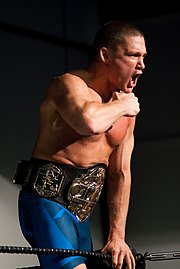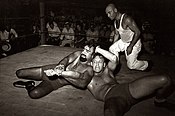
| Part of a series on |
| Professional wrestling |
|---|
 |
Professional wrestling in New Zealand has been promoted in the country from the early 20th century. In 1919, Gisborne Katene became the first national heavyweight champion, though the title was not recognized by the National Wrestling Association until 1925, and promoter Walter Miller began running events under the Dominion Wrestling Union banner ten years later.
It was not until the years following the Second World War that professional wrestling enjoyed its first golden age. Pat O'Connor, a one-time NWA and AWA World Heavyweight Champion, was one of the earliest stars of that era. During the 1960s and 1970s, other wrestlers from New Zealand also travelled to the United States, where they enjoyed similar success in the National Wrestling Alliance and the World Wide Wrestling Federation. American wrestlers frequently toured New Zealand during this period and were well received by the public. The NWA World Heavyweight Championship was also defended several times in the country; in 1984 Ric Flair won the title from Harley Race in Wellington and Jeff Jarrett defeated Sting in Auckland to unify the title with Australia's WWA World Heavyweight Championship in 2003.
As in the United Kingdom, its popularity was helped through a weekly television show, On the Mat, that showcased many wrestlers from around the world in the 1970s and early 1980s. Although professional wrestling in New Zealand declined following the 1980s wrestling boom, it still maintained a presence in the industry. Retired wrestler and promoter Steve Rickard briefly served as President of the NWA during the mid-1990s. Jason Conlan, a New Zealand-born cartoonist known as Pro Wrestling Illustrated's "Mr. J", began drawing a popular comic strip for the publication in 1995. Sharon Mazer of Auckland University of Technology wrote a series of articles on professional wrestling and published Professional Wrestling: Sport and Spectacle in 1998. Since 2003, its popularity has returned following the emergence of several independent promotions, and with it the reappearance of televised wrestling, bringing professional wrestling back into the popular culture of New Zealand.
